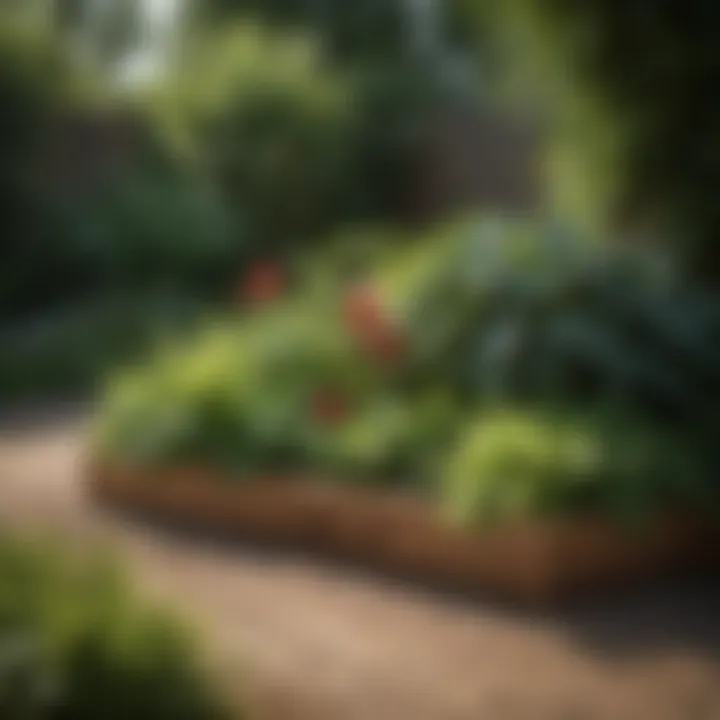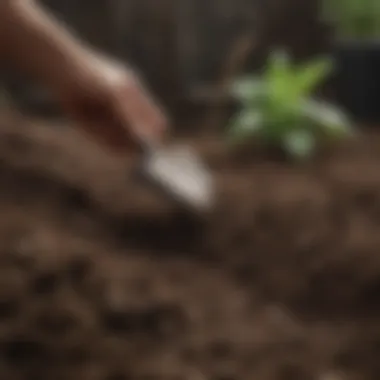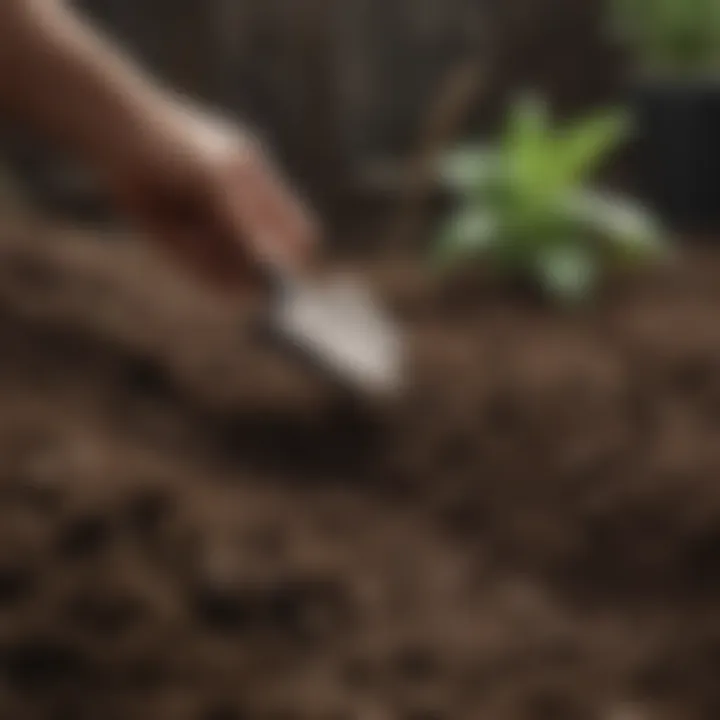How to Start a Garden Bed: A Comprehensive Guide


Intro
Starting a garden bed is a rewarding endeavor that invites nature into your personal space while also enhancing your lifestyle. It offers both aesthetic beauty and practical benefits, such as homegrown produce or flowers that brighten your day. Locating the right place for your garden bed is fundamental; sunlight, drainage, and proximity to water sources play crucial roles in the thriving of your plants. This guide aims to provide a thorough look at the essential steps required to establish a successful garden bed, appealing to both novice gardeners and seasoned green thumbs.
Design Inspiration
Establishing a garden bed needn't just be a functional task; it can be a chance to exhibit personal style. When determining the aesthetic of your garden, consider how it complements your home or outdoor area.
Current Trends in Garden Design
In recent years, gardening trends have tilted toward sustainable practices and biodiversity. Here, wildflower mixes, native plants, and pollinator gardens take center stage. The focus on native flora isn't merely about beauty; it helps promote local ecosystems and encourages beneficial insects.
Color Schemes and Palette Ideas
When visualizing the color palette for your garden, think beyond just floral hues. The interplay of foliage color, textures, and seasonal changes can provide striking visuals. For example:
- Bold and Bright: Opt for vibrant blooms like sunflowers or zinnias.
- Soft and Subtle: Choose pastel shades with lavender or pansies for a calming feel.
- Earthy and Natural: Greens, browns, and deep reds can create a rustic aesthetic.
Gardening Techniques
Now that you have a sense of design, the next step is to delve into the methods that will ensure your garden thrives.
Plant Selection and Care
Choosing the right plants is not merely a matter of preference; it’s about understanding your environment. Research the sunlight, soil type, and climate of your area. Things to consider:
- Annuals vs. Perennials: Annuals require replanting each year, while perennials can return season after season.
- Growth Conditions: Certain plants thrive in full sun while others prefer shadier spots.
- Water Requirements: Be mindful of the moisture needs.
Indoor vs. Outdoor Gardening
The choice between indoor and outdoor gardening can greatly influence your overall experience. Indoor gardening often comes with more control over conditions like light and humidity, making it ideal for herbs and smaller plants. Conversely, outdoor gardening offers a more extensive selection and is upscale for veggies or larger blooms.
A well-planned garden bed not only serves as a visual delight but also contributes to your well-being.
Balancing practicality with design makes for a fulfilling experience as you cultivate your green space. Embrace the journey of gardening; it's an ongoing learning process that has much to offer. With the right approach and care, your garden bed will flourish into a vibrant part of your home.
Understanding Garden Beds
Understanding garden beds is essential for anyone looking to cultivate a thriving garden. It's more than just placing some dirt in a box and hoping for the best; it involves careful thought and preparation. By grasping the ins-and-outs of garden beds, gardeners can create environments that not only boost the plant's health but also enhance the overall landscape. Choosing the right type of garden bed is foundational to achieving success, as each variety offers unique benefits and styles to suit different needs and preferences.
Definition of a Garden Bed
A garden bed can be simply defined as an area dedicated to growing plants. However, this might not paint the full picture. It's precisely this area that becomes an ecosystem, allowing for the nurturing of various plants, flowers, and vegetables. Think of it as a designated space where soil health, water management, and light exposure come together harmoniously to support plant growth. It’s the canvas upon which a gardener creates their own little digestive bio-sphere, in a way.
Types of Garden Beds
Garden beds manifest in various forms, each tailored for specific gardening goals. Take a closer look at a few of the main types:
In-ground
In-ground garden beds are perhaps the most traditional option. They are literally just plots of land that have been tilled and enriched for planting. One of the key characteristics of in-ground beds is that they rely heavily on the existing soil, making them a feasible choice for gardeners who have quality topsoil.
A unique feature of in-ground beds is their vast potential for space. If you’ve got the room, they allow for expansive vegetable gardens or beautiful flower beds. However, this approach might come with downsides such as drainage issues if the soil is compacted or too clay-heavy.
Raised
Raised garden beds offer a modern twist that tackles some drawbacks of their in-ground counterparts. Essentially, these beds are constructed above the ground, usually framed with wood or other materials, and filled with a specially mixed soil. This elevates the gardening space, making it more accessible. A prime advantage is the improved drainage and soil quality, as the gardener has control over the soil composition.
Yet, they can be a bit more labor-intensive to build and require ongoing maintenance, like replenishing soil and controlling erosion. Plus, you'll want to keep an eye on the materials used in the construction to ensure they don't leach harmful chemicals into the soil.
Container
Container gardening is where flexibility shines. Whether you’re working with limited space on a balcony or a full-fledged backyard, containers can be adapted to fit almost any environment. The beauty of container beds lies in their versatility; you can move them around as needed.
Key to this type of gardening is the ease of controlling soil and sunlight exposure. However, they can dry out faster than in-ground or raised beds, requiring strapped watering schedules. Also, not all plants thrive in containers, so careful selection is crucial for success in this setting.
Benefits of Utilizing Garden Beds
Utilizing garden beds comes with a suite of advantages:
- Improved Soil Health: Each type of garden bed can be optimized for better soil health.
- Enhanced Drainage: Elevated designs help prevent waterlogging, a common concern in traditional beds.
- Easier Maintenance: Design choices can simplify tasks like weeding and harvesting.
- Aesthetics and Creativity: With various styles and layouts available, gardeners can express their creativity.
Choosing the Right Location
Selecting where to place your garden bed isn’t just a minor detail; it’s fundamental. The garden's location can dictate how well your plants thrive or struggle. A proper spot can harness various natural elements such as sunlight, accessibility, and water, essentially providing your garden with a fighting chance against the odds. The significance of this choice cannot be overstated, as it lays the groundwork for many aspects of gardening success and enjoyment.
Sunlight Requirements
Sunlight serves as the engine driving plant growth. Each type of plant has its own requirements for sunlight, generally categorized into full sun, partial shade, and full shade. Full sun plants require at least six hours of direct sunlight daily, overcoming their competition for the coveted light.
Before setting the bed, assess the sunlight exposure in your chosen location. Watch the area at different times of the day. Look out for shadows cast by trees or buildings, especially as the seasons shift. There’s a common saying: "You reap what you sow," which rings especially true when it comes to sunlight. Make sure there’s no obstruction preventing those sunrays from kissing your plants.
Tips for Sunlight Assessment:
- Spend a few days observing the area.
- Take note of any changes with the weather.
- Use a simple shadow stick to mark sunlight patterns.
Accessibility and Convenience


Gardening can often mean getting your hands dirty, quite literally. Therefore, placing your garden bed in an accessible area is crucial. After all, who wants to trudge ten miles every time they need to check for pests? A conveniently located bed allows for regular inspection and care.
Consider foot traffic as well. Ideally, the garden should be easily reachable from your kitchen or living space. Not only does this ease the burden of maintenance, but it also encourages spontaneous snips of fresh herbs or flowers to garnish your meals. It comes down to a simple equation: more access equals more garden love.
Proximity to Water Sources
Water is the lifeline for any garden. It’s essential to consider how easy it is to get water to your garden bed. Dragging a heavy hose across the yard can easily turn an enjoyable task into a chore. Having your garden situated near a water source means less hassle. You might think about your local weather patterns too; elements like rainfall can play an important role in how often you'll need to water.
If you're planning to depend on rainwater or your local climate, think about the ease of capturing and distributing water effectively. A rain barrel can be a marvellous addition to collect those otherwise wasted drops, just waiting to nourish your plants.
"Good gardeners know that the secret to success is less about what to plant and more about where to plant it."
By paying attention to these elements—sunlight, accessibility, and water—you’re laying a solid foundation for a productive garden. With the right spot picked out, you’ll find yourself one step closer to cultivating that green oasis you’ve dreamed of.
Preparing the Ground
Preparing the ground for your garden bed is crucial, as it sets the foundation for everything that follows. A solid start means healthier plants, better yields, and reduced headaches down the line. If you dive straight into planting without laying the groundwork properly, you may find yourself struggling with poor growth or even plant failure.
Backyard soil can be a mixed bag. It can have too much clay or be sandy — both of which can cause issues for your veggies and flowers alike. By tending to your soil before planting, you're giving your garden the best chance possible.
Clearing the Area
Before you can get your hands dirty, you need to roll up your sleeves and clear the area designated for your garden bed. This means removing any existing grass, weeds, or debris. It might seem like a brute task, but it’s necessary. You can't expect a fruitful garden if it has to compete with unwanted plants for nutrients and water.
Start by marking the boundaries of your garden bed. You can use garden stakes or even some string to visualize where it'll go. Once that’s done, grab a shovel and get to digging! It helps to remove grass and weeds entirely to avoid any unforeseen complications later. If you're in for a bigger operation, consider using a garden tiller.
Soil Testing
Testing your soil is like getting a health checkup for your yard. It’s essential to know what you’re working with — the PH level, nutrient composition, and organic matter present in your soil. Kits for soil testing are readily available at gardening shops or online. Some municipal cooperatives even offer them for free.
Now, you may ask yourself, "Why bother with testing?" Well, different plants have varying nutrient needs, and your soil’s current condition could dictate what thrives in your garden.
Improving Soil Quality
Once you’ve cleared your area and tested the soil, it’s time to roll up your sleeves and improve its condition. Think of this as feeding your soil so it can nourish your plants effectively.
Composting
Composting is often hailed as a game-changer in gardening practices. It’s the process of recycling organic material, like kitchen scraps, yard waste, and even paper, into rich, life-giving soil amendments. It’s not just beneficial; it’s a choice you can feel good about environmental-wise.
- Key Characteristic: Composting creates a natural fertilizer that adds beneficial microorganisms to your soil, which can improve plant growth and health.
- Unique Feature: It satisfies the soil’s hunger for nutrients and enhances water retention.
- Advantages: Using compost helps reduce waste, cuts down on the need for chemical fertilizers, and promotes microbial life in the soil.
However, the process can take some time, and you need to manage it properly to avoid unpleasant odors or pests.
Adding Nutrients
Sometimes, the addition of specific nutrients to your soil can really work wonders. This could mean using bone meal for phosphorus or blood meal for nitrogen — they each serve distinct purposes in plant health.
- Key Characteristic: Adding nutrients allows you to tailor your soil for particular plant types, promoting better growth and disease resistance.
- Unique Feature: You can target deficiencies in your soil that may not be addressed by composting alone.
- Advantages: This practice provides a quick boost to soil health, but you must test regularly to avoid over-fertilization, which can harm your plants.
In sum, preparing your ground is the first step in a rewarding gardening journey. Each practice, from clearing the area to enriching your soil, lays the foundations for a successful and fruitful garden bed.
Designing Your Garden Bed
Designing your garden bed is where creativity meets functionality. It's not just about plopping a few plants into the ground; it’s a deliberate process that can enhance the overall success of your garden. The layout and selection of plants can impact growth, maintenance, and the aesthetics of your outdoor space. A carefully thought-out design offers various benefits, such as better space utilization, easier access for maintenance, and an opportunity to express your personal style through plant choice and arrangement.
Layout and Dimensions
Getting the layout right can make or break your gardening experience. The dimensions of your garden bed will dictate the types of plants you can grow, how they’ll thrive, and how you’ll access them for care. Begin by measuring the area available and understanding the sun's trajectory over your garden space.
Consider a rectangular bed for maximum planting surface, or maybe a circular one for aesthetic joy. Traditional sizes, like 4x8 feet, allow for easy gardening practices without reaching too far into the middle. The arrangement of plants is also key. Adopting a square-foot gardening method could be your ticket to growing more in less space, which especially suits folks with smaller yards.
Choosing Plant Varieties
Selecting the right plants is as crucial as positioning them effectively. A balanced mix of annuals and perennials can create a dynamic landscape over the seasons, ensuring there’s always something to look at.
Annuals vs. Perennials
When it comes to choosing between annuals and perennials, understanding their differences is vital. Annuals, such as marigolds and petunias, complete their life cycle within one growing season. They bloom profusely in a short time, making them a popular choice for a burst of color. However, they need to be replanted every year, which can add up in terms of time and cost.
Perennials, like coneflowers and daylilies, come back year after year and often require less maintenance once established. Their unique feature is resilience, providing consistent returns for the effort invested initially. However, keep in mind that their bloom time may be shorter compared to the cheerful, flashy annuals.
Both plant types can coexist beautifully, offering a variety of colors and textures that change throughout the year. Understanding their growth habits will help you make informed decisions that will aid in crafting a thriving garden that meets your vision.
Companion Planting
Companion planting is another strategy that can yield rich rewards in your garden bed. This method involves pairing plants that benefit each other – think tomatoes and basil.
The key characteristic of companion planting is mutual support, whether through pest deterrence, nutrient enhancement, or physical structure. Basil not only enhances the flavor of tomatoes but also repels harmful insects, making it a win-win scenario. This approach can lead to healthier plants and potentially higher yields.
However, caution is required as not all plants harmonize well together. For example, planting carrots with dill can lead to stunted growth for one or both plants. Knowing which pairs work well together can greatly enhance the productivity of your garden bed.
Incorporating Aesthetics
While the practical side of gardening takes priority, aesthetics shouldn’t be ignored. Incorporating visual elements can turn your garden bed into a peaceful retreat or a vibrant gathering spot.
Color Schemes


When considering color schemes, think of how different plants complement or contrast each other. A thoughtfully curated palette can transform your space – soft pastels can create tranquility, while bright colors evoke energy.
Additionally, varying heights and bloom times can keep visual interest throughout the growing season. A well-designed color scheme can make you smile every time you step into your garden, making it more of a haven than a chore.
Textures
Textures bring another layer of depth to your garden bed design. Mixing smooth foliage with coarse leaves adds visual contrast. Consider pairing ornamental grasses with flowering plants for a more engaging look.
The unique feature lies in how textures can affect spatial perception. Using varying textures not only draws the eye but can also help make a small space feel larger and more inviting. A thoughtful texture blend can draw visitors in and encourage exploration of your garden.
"A well-planned garden bed offers a symphony of colors, textures, and growth patterns, inviting all who encounter it to pause and appreciate nature's beauty."
In summary, designing your garden bed is more than simple organization; it's a chance to emphasize elements that mirror your vision. From layout to aesthetics, each choice you make helps contribute to a thriving garden bed that not only grows plants but also nurtures your gardening passion.
Implementing the Garden Bed
Once you have chosen the right location and prepared the groundwork, it’s time to dive into the heart of gardening—implementing the garden bed. This phase is pivotal, as it translates your planning into actual growth. When carefully executed, these steps ensure that your plants establish roots and thrive.
Planting Techniques
Planting may seem straightforward, but there are nuances that can significantly influence the success of your garden bed. First off, the timing is crucial. Each plant has its own preferred planting time, often dictated by the season and climate. For example, cool-season crops like spinach and peas flourish when sown in early spring, while warm-season crops like tomatoes and peppers thrive in late spring and summer.
Next, consider spacing. Overcrowding plants slows down their growth due to competition for sunlight, water, and nutrients. Take the time to check seed packets or plant labels for spacing recommendations.
Then, there’s the depth of the planting hole. Generally, seeds should be planted at a depth that’s about two to three times their diameter. A light touch when covering them with soil can prevent damage to tender seedlings. Planting techniques may vary for different garden types:
- Row Planting: Ideal for in-ground gardens, where seeds or seedlings are planted in straight lines.
- Square Foot Gardening: A compact method that maximizes space, often used in raised beds, allowing for a grid-style planting.
Consider adding companion plants—plants that mutually benefit each other when grown together. For instance, growing marigolds near tomatoes can deter pests naturally. Overall, effective planting techniques serve as the cornerstone for a productive garden bed.
Watering Strategies
Watering is not merely about keeping your plants damp; it's an art form. Understanding how much and how often to water can dramatically affect your plants' health. Overwatering can suffocate the roots and make soil too soggy, which, let’s face it, isn’t the ideal scenario. Conversely, underwatering can leave your plants thirsty and stressed.
Start by considering the type of plants you are growing. Some plants thrive on a wet diet, while others enjoy a more arid environment. When watering, focus on deep watering rather than frequent, shallow sprinklings. Water directly at the base of the plants in the morning or late afternoon to minimize evaporation. It’s essential to keep the soil moist but not soaked.
To gauge moisture levels, it’s helpful to use your fingers — just poke around in the soil a bit. If the top inch feels dry, then it’s probably time to hit the watering can. You might also consider efficient methods like drip irrigation or soaker hoses, which can save time and water while ensuring plants get their fair share without waterlogging.
Mulching and Weed Control
Mulching is like giving your plants a cozy blanket. Mulch serves to regulate soil temperature and retain moisture while also suppressing weeds that compete for precious nutrients and space. Using organic materials such as straw, wood chips, or shredded leaves not only benefits the soil over time as they break down but provides a finished look to your garden bed.
When applying mulch, aim for a thickness of 2-4 inches, keeping it clear from the plant stems to prevent rot.
Weed control is another significant aspect of maintaining your garden bed. Weeds can pop up and take over faster than you can say ‘garden growth’. Regular weeding is necessary, preferably done after rain or watering when the soil is soft. Pulling them out by the roots, rather than just cutting them off, goes a long way in preventing their regrowth. Consider also the use of landscape fabric to block weed growth while allowing air and water to permeate.
In essence, the successful implementation of a garden bed hinges on your attention to detail. Through proper planting, watering, and mulching techniques, you create a sustainable environment where your plants can flourish. As each aspect comes together, you will witness the transformation from bare earth to a vibrant, functional garden bed.
Maintaining Your Garden Bed
Maintaining your garden bed is like the oil in a well-running machine. Without proper upkeep, your beautiful efforts could quickly go south. Regular maintenance ensures that your plants stay healthy, your soil remains productive, and you can enjoy a vibrant garden throughout the seasons. While the thrill of planting is often the highlight for many, it’s the consistent care that really allows a garden to flourish and showcase its full potential.
Routine Care Practices
Caring for your garden bed doesn't have to be a chore. It can actually become quite therapeutic. Here are some essential practices to incorporate into your routine:
- Watering: Regular watering is crucial. Depending on your climate and plant choices, you may water daily or every few days. Check the soil moisture by digging a little – if it’s dry several inches down, it’s time to water.
- Weeding: Weeds are the unwanted guests at your garden party. Pull them out regularly to prevent them from competing with your plants for nutrients.
- Pruning: Just like a haircut, pruning promotes growth. Trim back overgrown plants to encourage new foliage and flowers.
- Fertilizing: Periodic feeding can make a world of difference. Use organic fertilizers, like compost or well-rotted manure, to keep your plants nourished.
By embracing these practices, you're not just nurturing plants; you're also building a deeper connection with your garden.
Pest Management Approaches
Pests can rain on your gardening parade, often showing up uninvited. Effective pest management is key to maintaining a healthy garden. Here are a few approaches to consider:
- Natural Predators: Welcome beneficial insects like ladybugs and lacewings that feast on aphids and other pests. These tiny allies can be a gardener’s best friend.
- Companion Planting: Some plants naturally repel pests. For instance, marigolds can deter nematodes, while basil can ward off flies. Plant these alongside your veggies and herbs for organic pest control.
- Crop Rotation: Changing where you plant your crops each season can disrupt pest life cycles, preventing infestations from recurring.
- Physical Barriers: Using row covers or nets can protect your plants from direct attacks, particularly in the early stages of growth.
By integrating these strategies, you minimize reliance on chemical solutions, fostering a healthier and more natural garden environment.
Seasonal Adjustments
As the seasons change, so should your gardening tactics. Adapting your care routine seasonally is essential to cater to different plant needs:
- Spring: This is the prime time for planting and rejuvenating your garden. Focus on mulching and enriching the soil after winter’s rest.
- Summer: Keep an eye on hydration. During hot spells, your garden will consume more water. Late summer might call for additional pruning to prepare for fall.
- Fall: Time to reap what you sow! Harvest your produce, clean up dead plants, and start thinking about winter beds or cover crops to protect soil health.
- Winter: If you live in a colder area, a protective cover for your garden will help keep it safe from frost. Mulching can also provide insulation.
By understanding and adjusting to your garden’s seasonal rhythms, you ensure that your bed is always in top-notch shape.
"A garden can be a wondrous place if tended to with a watchful eye and caring hands."
Maintaining your garden bed is not just about hard work; it is about cultivating an experience that changes with the seasons, allowing you to savor the fruits of your labor all year long.
Harvesting and Enjoying Your Garden
Harvesting your garden is like reaping the rewards of your hard labor. It’s the moment when you see the fruits of your efforts, literally and figuratively, coming to life. This section highlights why this phase is so crucial and what considerations are involved in savoring your bounty. Not only does harvesting mean enjoying fresh produce, but it also reflects successful gardening practices. You're not just gathering food; you're celebrating your gardening journey. In this context, the way you recognize harvest time, the techniques you use, and how you incorporate the produce into your meals are all essential.
Recognizing Harvest Time
Knowing when to pick your crops is critical. Different plants have different signals for when they’re ready to be harvested. Here are some general tips:


- Color and Size: This is often the first hint. For example, tomatoes should be fully colored and firm but not overripe.
- Feel: Some vegetables, like peppers, will feel mature when they’re full and have a slight firmness.
- Taste: If you’re unsure, tasting is a sure way to gauge readiness. Many gardeners taste-test to see if the flavor has developed adequately.
It’s important to pay attention to these signs. For instance, waiting too long can result in overripened fruits and spoiled veggies. Conversely, harvesting too early may lead to an unpleasant taste or texture.
Best Practices for Harvesting
When it’s time to gather your crops, knowing the best practices can make all the difference:
- Use the Right Tools: A sharp knife or garden shears can help avoid damaging the plant.
- Gentle Handling: Be easy on your produce. Bruises can lead to quicker spoilage.
- Harvest in the Morning: Picking in the cooler hours can help keep your veggies fresh longer.
- Follow the Weather: After rain, wait for the soil to dry a bit before harvesting. Excess moisture can affect the quality of the produce.
Taking these measures ensures that your harvest remains vibrant and flavorful as it's collected. "The joy of fresh, homegrown produce is unparalleled. Careful harvesting fosters not only quality in your food but also a deeper connection to the planting and growing process."
Incorporating Produce into Meals
Once you've collected your bounty, the fun continues in the kitchen. Fresh garden produce not only enhances the quality of your meals but can inspire creativity. Here are some ideas on how to use your harvest:
- Salads: Fresh greens, tomatoes, cucumbers, or whatever you've grown make for delicious salads.
- Stir-Fries: Quick cooking retains nutrients and flavors. Toss your harvest with some spices and a protein for a quick meal.
- Preserving: If you have a bumper crop, learning how to can or pickle some of your produce lets you enjoy them long after the season ends.
Not only do these dishes taste better with fresh ingredients, but they also deepen your appreciation for the effort you put into gardening. The colors, flavors, and scents all come together to make each meal unique and meaningful.
Sustainable Gardening Practices
Sustainable gardening practices lay the groundwork for a thriving garden that is not only beautiful but also environmentally friendly. This approach goes beyond simply growing plants—it's about creating a harmonious ecosystem that nurtures both plants and wildlife. When you adopt sustainable practices, you make choices that benefit the earth while enhancing your gardening experience.
Understanding Organic Principles
The backbone of sustainable gardening often rests in organic principles. This means avoiding synthetic fertilizers and pesticides, which can be harmful to the environment and disrupt the balance of local ecosystems. Instead, consider natural alternatives. For example, plant marigolds to deter pests or use neem oil for pest control. By nurturing the soil with organic compost, you promote healthier plants and improve soil fertility.
Adhering to organic guidelines also means being mindful of the plants you choose. Selecting native plants helps maintain local biodiversity and minimizes water usage. You’re not just fighting against problems—you're building an ecosystem that thrives on its own.
Implementing Local Biodiversity
Biodiversity is vital in creating a sustainable garden. By planting a variety of species, from flowers to vegetables, you create a habitat that attracts beneficial insects and discourages pests. This diversity can also improve pollination, leading to better yields and healthier plants.
Additionally, consider incorporating plants that are well-adapted to your local climate. Native species require less water and maintenance, making them an ideal choice. They provide sustenance and shelter to local wildlife, fostering a balanced ecosystem. Simple practices, like creating a small pond or leaving some areas of your garden wild, can further enhance biodiversity by attracting frogs, birds, and beneficial insects.
"The garden should be a place that gives back to the earth, sustaining both the gardener and the environment."
Water Conservation Techniques
Conserving water is a cornerstone of sustainable gardening, especially in regions prone to drought. Implementing efficient irrigation systems, like drip irrigation, can significantly reduce water wastage. These systems deliver moisture directly to plant roots, minimizing evaporation and runoff.
Rainwater harvesting is another effective technique. By installing a rain barrel, you can collect rainfall from your roof and use it to water your plants. This not only saves on your water bill but is also a great way to leverage natural resources.
Mulching is another strategy worth considering. Adding a layer of organic mulch around your plants helps retain moisture in the soil, suppress weeds, and improve soil quality as it breaks down. Simple adjustments in your watering routine, like watering early in the morning or late in the evening, can also decrease evaporation.
The journey to sustainable gardening practices might seem daunting at first, but with every small step, you're making a positive impact. Whether it’s choosing organic methods, promoting biodiversity, or conserving water, this is a way to cultivate your garden in a manner that respects and preserves our planet.
Overcoming Common Challenges
Gardening can be a rewarding endeavor, but it also comes with its fair share of challenges. Understanding how to overcome these obstacles is crucial for any gardener looking to create a thriving garden bed. It’s not just about planting seeds and waiting for them to sprout; it involves careful planning and adaptability. Addressing challenges such as weather variability, soil health, and space limitations helps ensure that the plants flourish. By focusing on these aspects, gardeners can achieve sustainability in their practices while enjoying the fruits of their labor.
Dealing with Adverse Weather
Adverse weather conditions can be a gardener's worst nightmare. From unexpected frosts to relentless heat waves, these climatic shifts can hinder growth and even cause plants to perish. Firstly, it’s essential to monitor local weather patterns to anticipate changes. For instance, if forecasts predict a sudden cold snap, consider covering your tender plants with fabric or plastic to shield them from frost damage.
Additionally, understanding each plant’s tolerance to heat and cold is important. Choose varieties that are well-adapted to local climate conditions. Hardy plants, such as kale and certain herbs, can withstand low temperatures better than others. On hot days, shade cloths or temporary structures can provide necessary relief for sun-sensitive plants.
Remember: Weather is unpredictable, so being proactive is key to weathering the storm.
Combatting Soil Depletion
Soil is the backbone of any garden bed. Over time, soil can lose its nutrients, leading to depleted garden beds that fail to produce vibrant plants. To combat soil depletion, consider the practice of crop rotation and companion planting. By alternating what you plant in specific areas from season to season, you can help avoid nutrient loss and keep pests at bay. For example, planting legumes like beans can naturally fix nitrogen in the soil, enriching it for future crops.
Moreover, integrating organic matter into the soil, such as compost or aged manure, can significantly improve soil structure and nutrient levels. Regular soil testing is also recommended; it can save a gardener from unexpected surprises later on. If soil test results indicate low nutrient levels, instantaneous fixes can be applied.
Managing Limited Space
Not everyone has the luxury of vast backyards. If your gardening area is cramped, it’s crucial to maximize every square inch. Vertical gardening is an excellent approach to consider. By utilizing trellises, wall planters, or even hanging pots, you can grow plenty of plants without taking much ground space.
In addition to growing upwards, focus on planting densely. For instance, instead of leaving space between plants, closely sow seeds of fast-growing varieties alongside slower ones. This can create a multi-layered environment where each plant contributes to the overall ecosystem of the garden.
Ultimately, think outside the box—literally! Use containers on balconies, rooftops, or porches to expand your gardening horizons and enjoy a variety of herbs, vegetables, or flowers without dedicated garden beds.
Cultivating a garden can be a challenge, but through informed strategies and creativity, these obstacles can be turned into stepping stones towards a flourishing garden.
Ending
In this exploration of establishing a garden bed, we have traversed through numerous essential aspects that contribute to not just planting, but to nurturing a relationship with the earth. Establishing a garden bed is not merely an act of cultivating plants but a journey of self-discovery and growth. One must reflect on the elements that intertwine—the toil of preparation, the patience of nurturing, and the eventual joy of harvest. These are integral to laying the foundation of a fruitful gardening endeavor and foster deeper connections with our environment.
Reflecting on Growth and Learning
As one embarks on the journey of gardening, reflection becomes a powerful tool. Each season brings new lessons, whether it’s understanding the intricacies of soil types, the fickle nature of weather, or the compatibility of plant companions. For instance, you might find that your marigolds are thriving where the cucumbers failed. This realization pushes the envelope of your knowledge, urging you to adapt and experiment further. It's not merely about watching plants grow, but also about observing what works and what doesn’t. This heightened awareness can enhance your already blossoming skills, leading to richer, more vibrant gardens.
"The way you learn is through experience, through the roots of your garden, and understanding their language."
Encouragement to Experiment
Gardening is an art form that thrives on creativity and innovation. Don’t be afraid to push boundaries! Try different arrangements, mix up plant varieties, or explore unconventional gardening methods like vertical or permaculture gardening. Each choice you make unveils possibilities that not only satisfy aesthetics but can also yield unexpected benefits. Consider planting garlic alongside roses to deter pests or experimenting with native plants that require less maintenance.
By engaging in this creative experimentation, you're not just facilitating growth in your garden, you're cultivating a habit of curiosity and adaptability in life. Remember, every gardener encounters setbacks—be it pest invasions, less-than-ideal weather, or plants simply refusing to cooperate. Embrace these challenges, learn from them, and use them as stepping stones for your next gardening adventure.
In summary, the path to a successful garden bed is about more than just plants; it’s about continual learning, growth, and the joy of experimenting. As you put in the effort today, you lay the groundwork for future gardens, and perhaps even stir motivation in others to embark on their own horticultural journeys.



